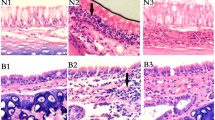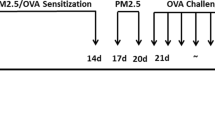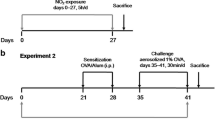Abstract
Allergic rhinitis (AR) represents a clinical health issue affecting approximately 500 million people worldwide. This study aimed to explore the effects of airborne fine particulate matter (PM2.5) on the nasal mucosa of rats with AR. Seventy-five healthy male SD rats were included and randomly divided into the normal, model, low-concentration, middle-concentration, and high-concentration groups (15 rats each group). AR rat models were established using sensitized mixture and were stimulated using different concentrations of PM2.5. Sneeze and nose-scratching events were observed. Automatic hematology analyzer was utilized to count white blood cells (WBCs). The serum IgE, ICAM-1, and VCAM-1 expressions, eosinophil (EOS) infiltration, and IFN-γ, IL-4, IL-5, IL-33, and TSLP expressions were detected by ELISA, HE staining, and qRT-PCR. Greater numbers of WBCs, increased IgE level, elevated levels of ICAM-1, VCAM-1, EOS, IFN-γ, IL-4, IL-5, IL-33, and TSLP in the model, low-concentration, middle-concentration, and high-concentration groups than the normal group. The same trend also exhibited in rats of the middle-concentration and high-concentration groups than that of the model and low-concentration groups. Comparisons between normal rats and AR rats indicated that AR rats exhibit remarkably higher cytokine expression levels of IFN-γ, IL-4, IL-5, TSLP, and IL-33. The study revealed that as stimulation is triggered by PM2.5, AR rats result in increased levels of adhesion molecules and inflammatory cytokine expressions in a concentration-dependent manner. Analyses of PM2.5 as well as, its effects on AR are crucial in the continued drive for both prevention and management of the disease.





Similar content being viewed by others
References
Bousquet J, Khaltaev N, Cruz AA, Denburg J, Fokkens WJ, Togias A et al (2008) Allergic rhinitis and its impact on asthma (ARIA) 2008 update (in collaboration with the World Health Organization, GA(2)LEN and AllerGen). Allergy 63(Suppl 86):8–160. doi:10.1111/j.1398-9995.2007.01620.x
Meltzer EO, Blaiss MS, Naclerio RM, Stoloff SW, Derebery MJ, Nelson HS et al (2012) Burden of allergic rhinitis: allergies in America, Latin America, and Asia-Pacific adult surveys. Allergy Asthma Proc 33(Suppl 1):S113–S141. doi:10.2500/aap.2012.33.3603
Wilson DR, Lima MT, Durham SR (2005) Sublingual immunotherapy for allergic rhinitis: systematic review and meta-analysis. Allergy 60(1):4–12. doi:10.1111/j.1398-9995.2005.00699.x
Licari A, Castagnoli R, Bottino C, Marseglia A, Marseglia G, Ciprandi G (2016) Emerging drugs for the treatment of perennial allergic rhinitis. Expert Opin Emerg Drugs 21(1):57–67. doi:10.1517/14728214.2016.1139082
van Cauwenberge P, Bachert C, Passalacqua G, Bousquet J, Canonica GW, Durham SR et al (2000) Consensus statement on the treatment of allergic rhinitis. Eur Acad Allergol Clin Immunol Allergy 55(2):116–134
Higgins TS, Reh DD (2012) Environmental pollutants and allergic rhinitis. Curr Opin Otolaryngol Head Neck Surg 20(3):209–214. doi:10.1097/MOO.0b013e3283534821
Chang HH, Peng RD, Dominici F (2011) Estimating the acute health effects of coarse particulate matter accounting for exposure measurement error. Biostatistics 12(4):637–652. doi:10.1093/biostatistics/kxr002
Becker S, Soukup J (2003) Coarse(PM(2.5-10)), fine(PM(2.5)), and ultrafine air pollution particles induce/increase immune costimulatory receptors on human blood-derived monocytes but not on alveolar macrophages. J Toxicol Environ Health A 66(9):847–859. doi:10.1080/15287390306381
Riva DR, Magalhaes CB, Lopes AA, Lancas T, Mauad T, Malm O et al (2011) Low dose of fine particulate matter (PM2.5) can induce acute oxidative stress, inflammation and pulmonary impairment in healthy mice. Inhal Toxicol 23(5):257–267. doi:10.3109/08958378.2011.566290
Rumelhard M, Ramgolam K, Hamel R, Marano F, Baeza-Squiban A (2007) Expression and role of EGFR ligands induced in airway cells by PM2.5 and its components. Eur Respir J 30(6):1064–1073. doi:10.1183/09031936.00085907
Rui W, Guan L, Zhang F, Zhang W, Ding W (2016) PM2.5-induced oxidative stress increases adhesion molecules expression in human endothelial cells through the ERK/AKT/NF-kappaB-dependent pathway. J Appl Toxicol 36(1):48–59. doi:10.1002/jat.3143
Perez Rueda C, Michavila A, Pereda A, Ferrer Calvete J (1986) Meconium ileum equivalent as a presenting form of cystic fibrosis. An Esp Pediatr 25(2):125–127
Nishijima H, Kondo K, Toma-Hirano M, Iwasaki S, Kikuta S, Fujimoto C et al (2016) Denervation of nasal mucosa induced by posterior nasal neurectomy suppresses nasal secretion, not hypersensitivity, in an allergic rhinitis rat model. Lab Invest 96(9):981–993. doi:10.1038/labinvest.2016.72
Gwak NG, Kim EY, Lee B, Kim JH, Im YS, Lee KY et al (2015) Xanthii Fructus inhibits allergic response in the ovalbumin-sensitized mouse allergic rhinitis model. Pharmacogn Mag 11(Suppl 2):S352–S361. doi:10.4103/0973-1296.166058
Baiardini I, Braido F, Tarantini F, Porcu A, Bonini S, Bousquet PJ et al (2008) ARIA-suggested drugs for allergic rhinitis: what impact on quality of life? A GA2LEN review. Allergy 63(6):660–669. doi:10.1111/j.1398-9995.2008.01649.x
Gavett SH, Haykal-Coates N, Copeland LB, Heinrich J, Gilmour MI (2003) Metal composition of ambient PM2.5 influences severity of allergic airways disease in mice. Environ Health Perspect 111(12):1471–1477
Liu G, Zhu R (2005) Serum IL-10 level in allergic rhinitis patients and its effect on serum total IgE. J Huazhong Univ Sci Technolog Med Sci 25(6):724–725
Deng X, Zhang F, Rui W, Long F, Wang L, Feng Z et al (2013) PM2.5-induced oxidative stress triggers autophagy in human lung epithelial A549 cells. Toxicol In Vitro 27(6):1762–1770. doi:10.1016/j.tiv.2013.05.004
Sharma RK, Pasqualotto AE, Nelson DR, Thomas AJ Jr, Agarwal A (2001) Relationship between seminal white blood cell counts and oxidative stress in men treated at an infertility clinic. J Androl 22(4):575–583
Becker S, Dailey L, Soukup JM, Silbajoris R, Devlin RB (2005) TLR-2 is involved in airway epithelial cell response to air pollution particles. Toxicol Appl Pharmacol 203(1):45–52. doi:10.1016/j.taap.2004.07.007
He M, Ichinose T, Ren Y, Song Y, Yoshida Y, Arashidani K et al (2015) PM2.5-rich dust collected from the air in Fukuoka, Kyushu, Japan, can exacerbate murine lung eosinophilia. Inhal Toxicol 27(6):287–299. doi:10.3109/08958378.2015.1045051
Weir CH, Yeatts KB, Sarnat JA, Vizuete W, Salo PM, Jaramillo R et al (2013) Nitrogen dioxide and allergic sensitization in the 2005–2006 National Health and Nutrition Examination Survey. Respir Med 107(11):1763–1772. doi:10.1016/j.rmed.2013.08.010
Dai L, Bind MA, Koutrakis P, Coull BA, Sparrow D, Vokonas PS et al (2016) Fine particles, genetic pathways, and markers of inflammation and endothelial dysfunction: analysis on particulate species and sources. J Expo Sci Environ Epidemiol 26(4):415–421. doi:10.1038/jes.2015.83
Park S, Seok JK, Kwak JY, Suh HJ, Kim YM, Boo YC (2016) Anti-inflammatory effects of pomegranate peel extract in THP-1 cells exposed to particulate matter PM10. Evid Based Complement Alternat Med. doi:10.1155/2016/6836080
Yatera K, Hsieh J, Hogg JC, Tranfield E, Suzuki H, Shih CH et al (2008) Particulate matter air pollution exposure promotes recruitment of monocytes into atherosclerotic plaques. Am J Physiol Heart Circ Physiol 294(2):H944–H953. doi:10.1152/ajpheart.00406.2007
Wilker EH, Alexeeff SE, Suh H, Vokonas PS, Baccarelli A, Schwartz J (2011) Ambient pollutants, polymorphisms associated with microRNA processing and adhesion molecules: the Normative Aging Study. Environ Health 10:45. doi:10.1186/1476-069X-10-45
Xing YF, Xu YH, Shi MH, Lian YX (2016) The impact of PM2.5 on the human respiratory system. J Thorac Dis 8(1):E69–E74
Ryan PH, Bernstein DI, Lockey J, Reponen T, Levin L, Grinshpun S et al (2009) Exposure to traffic-related particles and endotoxin during infancy is associated with wheezing at age 3 years. Am J Respir Crit Care Med 180(11):1068–1075. doi:10.1164/rccm.200808-1307OC
Zhu DD, Zhu XW, Jiang XD, Dong Z (2009) Thymic stromal lymphopoietin expression is increased in nasal epithelial cells of patients with mugwort pollen sensitive-seasonal allergic rhinitis. Chin Med J (Engl) 122(19):2303–2307
Gluck J, Rymarczyk B, Rogala B (2012) Serum IL-33 but not ST2 level is elevated in intermittent allergic rhinitis and is a marker of the disease severity. Inflamm Res 61(6):547–550. doi:10.1007/s00011-012-0443-9
Verma V, Fang T, Xu L, Peltier RE, Russell AG, Ng NL et al (2015) Organic aerosols associated with the generation of reactive oxygen species (ROS) by water-soluble PM2.5. Environ Sci Technol 49(7):4646–4656. doi:10.1021/es505577w
Baraniuk JN, Kim D (2007) Nasonasal reflexes, the nasal cycle, and sneeze. Curr Allergy Asthma Rep 7(2):105–111
Diaz-Sanchez D, Penichet-Garcia M, Saxon A (2000) Diesel exhaust particles directly induce activated mast cells to degranulate and increase histamine levels and symptom severity. J Allergy Clin Immunol 106(6):1140–1146. doi:10.1067/mai.2000.111144
Acknowledgements
We thank the reviewers for critical comments.
Author information
Authors and Affiliations
Corresponding author
Ethics declarations
Conflict of interest
The authors declare that they have no conflict of interest.
Ethical approval
All applicable international, national, and/or institutional guidelines for the care and use of animals were followed.
Informed consent
Informed consent was obtained from all individual participants included in the study.
Rights and permissions
About this article
Cite this article
Wang, YL., Gao, W., Li, Y. et al. Concentration-dependent effects of PM2.5 mass on expressions of adhesion molecules and inflammatory cytokines in nasal mucosa of rats with allergic rhinitis. Eur Arch Otorhinolaryngol 274, 3221–3229 (2017). https://doi.org/10.1007/s00405-017-4606-8
Received:
Accepted:
Published:
Issue Date:
DOI: https://doi.org/10.1007/s00405-017-4606-8




